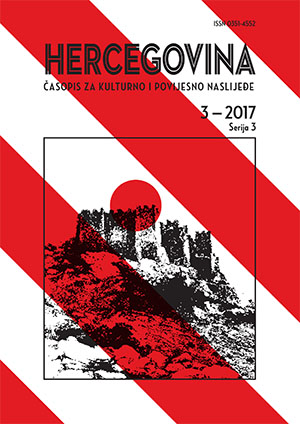Recepcija hercega Stjepana Vukčića Kosače u udžbeničkoj literaturi i institucionalnoj memoriji u Hercegovini u drugoj polovici
20. stoljeća
Reception of the Herzog Stjepan Vukcic Kosaca in
Herzegovina in the Second Half of the 20th Century
Author(s): Božo Goluža, Dijana KoraćSubject(s): History, 15th Century, Post-War period (1950 - 1989), Transformation Period (1990 - 2010)
Published by: Filozofski fakultet Sveučilišta u Mostaru
Keywords: Herzog Stjepan Vukcic Kosaca; Herzegovina; reception; history textbooks; streets;
Summary/Abstract: With the aim of presenting the reception of the Herzog Stjepan Vukcic Kosaca in Hercegovina in the second half of the 20th century, the paper analyzes the contents of history textbooks that write about the life and work of the Herzog Stjepan and his presence in the names of streets,squares and institutions in Herzegovinian towns and municipalities.Considering the second half of the 20th century,most attention is paid to the period in which Bosnia and Herzegovina was one of the republics of the former Yugoslavia. To illustrate the contents from medieval history,or the ones related to Stjepan, most important are school curricula, in which, apart from the teaching units and lessons, the teaching of history was particularly indicative,when during this period the constant task was"spreading fraternity and unity" or "developing patriotic awareness among students", the emphasis being on teaching history of the "newer period". Judging by the curricula and the content of textbooks from the second half of the 20th century (at least those available to us), the youth of Herzegovina in the mentioned period could not learn much about this historical person whose name is associated with the name of the area in which they live. Namely,by looking at the texts of the textbooks up to the 90s, it is evident that the texts in the textbooks differ, both in scope and emphasis on certain facts. What all the authors mention is taking of the 'Herzog' title in 1448 and the fall of Herzegovina under the Ottoman rule, whereas all the other facts about the Herzog Stjepan vary from one text to another. As there were no official textbooks in the region of Herzegovina in the 90s of the 20th century, the paper,as an example, presents the texts only from two textbooks(one for elementary school and the other for grammar school) used in some schools in Herzegovina which worked according to the Croatian curriculum, where we can find hardly any information about the Herzog Stjepan. Finally, the results of the research of the Herzog's presence in the names of streets, squares and institutions of the Herzegovinian cities and municipalities show that the interest of some individuals and institutions, who want to give this historical person the significance he deserves, has only recently become evident. Namely, all the streets in Herzegovina named after the Herzog, as well as one institution,got this name after 1990.
Journal: Hercegovina. Časopis za kulturno i povijesno naslijeđe (Do 2018)
- Issue Year: 2017
- Issue No: 3
- Page Range: 247-271
- Page Count: 25
- Language: Croatian

